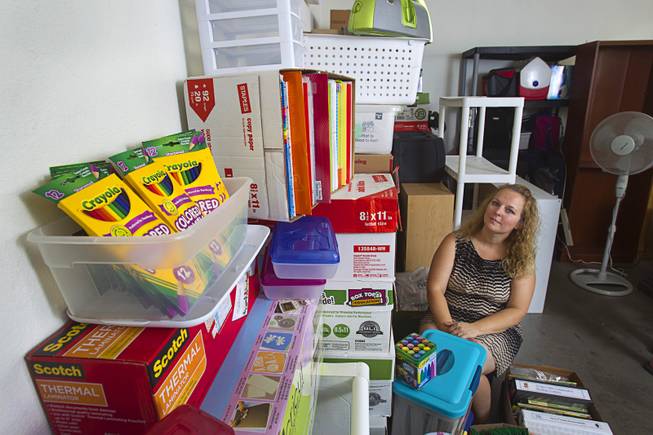
Kindergarten teacher Christine Cordova sits among school supplies stacked against a wall in the garage of her home in Henderson Sunday, July 27, 2014. Cordova rented a 19-foot U-Haul to pack up her classroom supplies from her old school as she prepares to move into a new school in the fall.
Friday, Sept. 16, 2016 | 2 a.m.
Related content
Imagine a having a job in which it’s assumed that you will spend hundreds of dollars out of your own pocket annually for basic supplies and equipment.
That’s the case for teachers in Clark County, especially those who work with students and families in poor areas.
Every year they buy pencils, markers, books, paper, folders, decorations and everything in between for their classrooms. It can be hard to quantify just how much teachers spend. The Clark County School District doesn’t have a policy on the issue, and teachers mostly take it as a given that they’ll have to dip into their own pockets to keep their classrooms stocked and decorated.
But an informal Facebook survey of about 130 CCSD teachers produced numbers ranging from $100 each year to more than $2,000 (5 percent of a teacher’s starting salary in CCSD).
The average of all the responses was about $750 per year, though many teachers noted that it could be much more or less depending on whether the teacher worked in a low-income school or at one in the suburbs.
It’s the reason why many schools send supply lists home to parents before school. The more families can chip in with their own money to buy supplies, the less teachers and schools have to foot the bill themselves.
“[I’m] easily around $400-$500, and I'm off to the store again this weekend,” teacher Carie Nelson said. “Too many kids didn't bring in supplies, so they drained what I had already purchased.”
In 2013 the National School Supply and Equipment Association figured the national average for out-of-pocket teacher spending to be about $485.
The association also calculated that teachers nationwide spent about $3.2 billion per year of their own money on classrooms in 2013, only about half of which was paid for by school districts. Ten percent of teachers surveyed by the NSSEA reported spending more than $1,000 per year.
The study also found that school districts are less likely to ask parents to help out. Only 25 percent of teachers in 2013 reported parents were asked to buy school supplies, down from 47 percent when the question was first asked in 2010.
“I've had to replace everything except furniture. I have spent right around $700 thus far and will probably spend another $200 throughout the year,” said Alma Alexander, a Wallin Elementary School teacher who will leave first grade to teach third grade next year. “Had I not switched grade levels, I would have spent around $300 throughout the year.”
But assuming that teachers might spend some of their own money on random classroom stuff each year, where does the school district fit in?
If you took $750 and multiplied it by 18,000 — the number of teachers in the school district — you get $13.5 million. Even assuming that number was too high and you settled for $10 million or even $5 million, it’s a fraction of the school district’s more than $3 billion budget.
“There’s not an expectation that teachers will buy textbooks, paper, the basics,” said Mike Barton, chief student achievement officer at CCSD. “Those are essentials, and the school does have a budget line to get those materials.”
However, anything outside of basic supplies is up to teachers, Barton said. Schools often will start their own funding drives to help teachers afford more, but many are forced to use their own funds.
“Teachers are just naturally good human beings,” Barton said. “Many of them go out there and buy things to optimize their lessons.”
As is the case with many problems within the school district, administrators say more funding would help, but there’s no guarantee the district would put that money toward repaying teachers.
Until then, teachers will have to make do with a lone reimbursement program set up by legislators last year. SB133 put $2.5 million into an account out of which teachers could apply to be reimbursed up to about $100 a year.
“The spirit of the legislation is positive, but it’s still not enough,” Barton said.

Join the Discussion:
Check this out for a full explanation of our conversion to the LiveFyre commenting system and instructions on how to sign up for an account.
Full comments policy